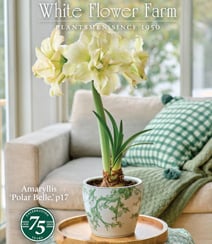How to grow plants in the south
We go to great lengths to learn all we can about the conditions each plant we offer requires. Because we garden in Connecticut, our knowledge base is necessarily Northeastern, but we understand full well that plants perform differently in different regions and that gardeners in the South face a set of conditions that sometimes demand growing instructions different from those we suggest to gardeners here. We have consulted gardening experts in the South on the care of the plants in our catalogue and have included many of their recommendations in this booklet. We also urge gardeners in the South to keep these general points in mind:
In the Northern Hemisphere, the intensity of the sun increases as one moves from north to south. For the gardener, this means that a plant that wants full sun or partial shade in the North may tolerate, or in fact require, partial shade or shade in the South. The sun and shade symbols used in this booklet refer to a plant's light needs in Litchfield. Where that plant's needs in the South differ, we have indicated as much in the text.
When the high heat and humidity typical of a southern summer coincide with a long dry spell, some plants fall prey to a fungus that causes them to rot away (or "mug off" or "melt out"), often overnight. The best prevention is to mulch plants to keep the soil as cool as possible (high soil temperature seems to trigger the rot) and to irrigate during periods of drought. If a plant mugs off despite your best efforts, prune away the affected growth. If the attack wasn't fatal (it isn't necessarily), the plant will produce fresh new growth when the weather cools. It's impossible to know when a particular plant is apt to mug off. It might thrive for several years and then succumb out of the blue. In that way, the phenomenon bears a resemblance to the effects Litchfield winters have on plants.
The bloom times listed in our catalogue and on our plant labels are typical of plants grown in Litchfield. In the South, the starting date and length of bloom depend on the time of year. Plants that begin to bloom in late winter or early spring generally start earlier and last longer than their counterparts in the North, which have to put on their show in the all-too-brief interlude between winter and summer. Summer bloomers in the South often come and go in a hurry in the intense heat (protection from the midday sun can extend the length of bloom). In fall, plants may get a late start but they often flower longer than fall bloomers in the North.
In the South, the long growing season, coupled with consistently warm nights, encourages many plants to grow taller and wider than we indicate in our catalog and on our labels. At the same time, plants less tolerant of heat may fail to reach the stature we are accustomed to here.
In many parts of the South, gardeners have to work with a heavy clay soil that drains poorly and bakes to an impenetrable crust in summer droughts. The solution is either to amend the soil with organic matter, as described in How to prepare the soil for planting , or to create raised beds by spreading a 6 - 12in layer of garden loam over the native soil. Timbers, stones, or bricks laid around the edge of a raised bed hold the loam in place.


